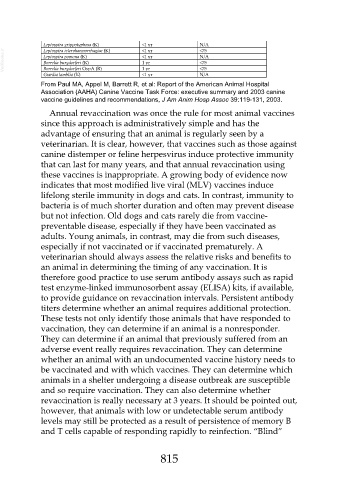Page 815 - Veterinary Immunology, 10th Edition
P. 815
Leptospira grippotyphosa (K) <1 yr N/A
VetBooks.ir Leptospira pomona (K) <1 yr N/A
<75
<1 yr
Leptospira icterohaemorrhagiae (K)
1 yr
<75
Borrelia burgdorferi (K)
Borrelia burgdorferi OspA (R)
Giardia lamblia (K) 1 yr <75
<1 yr
N/A
From Paul MA, Appel M, Barrett R, et al: Report of the American Animal Hospital
Association (AAHA) Canine Vaccine Task Force: executive summary and 2003 canine
vaccine guidelines and recommendations, J Am Anim Hosp Assoc 39:119-131, 2003.
Annual revaccination was once the rule for most animal vaccines
since this approach is administratively simple and has the
advantage of ensuring that an animal is regularly seen by a
veterinarian. It is clear, however, that vaccines such as those against
canine distemper or feline herpesvirus induce protective immunity
that can last for many years, and that annual revaccination using
these vaccines is inappropriate. A growing body of evidence now
indicates that most modified live viral (MLV) vaccines induce
lifelong sterile immunity in dogs and cats. In contrast, immunity to
bacteria is of much shorter duration and often may prevent disease
but not infection. Old dogs and cats rarely die from vaccine-
preventable disease, especially if they have been vaccinated as
adults. Young animals, in contrast, may die from such diseases,
especially if not vaccinated or if vaccinated prematurely. A
veterinarian should always assess the relative risks and benefits to
an animal in determining the timing of any vaccination. It is
therefore good practice to use serum antibody assays such as rapid
test enzyme-linked immunosorbent assay (ELISA) kits, if available,
to provide guidance on revaccination intervals. Persistent antibody
titers determine whether an animal requires additional protection.
These tests not only identify those animals that have responded to
vaccination, they can determine if an animal is a nonresponder.
They can determine if an animal that previously suffered from an
adverse event really requires revaccination. They can determine
whether an animal with an undocumented vaccine history needs to
be vaccinated and with which vaccines. They can determine which
animals in a shelter undergoing a disease outbreak are susceptible
and so require vaccination. They can also determine whether
revaccination is really necessary at 3 years. It should be pointed out,
however, that animals with low or undetectable serum antibody
levels may still be protected as a result of persistence of memory B
and T cells capable of responding rapidly to reinfection. “Blind”
815

